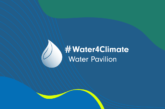
Almost the entire #PlanetEarth is confronted with alarming #watercrisis which is assuming serious proportions with the passage of time. #Waterproblems are no more merely remain confined to developing countries, rather now more developed countries are also feeling the pinch. The four-year California drought that cost the state an estimated $US 2.7 billion in 2015 is now steering local, state, and even national politics in the United States.
Water along with #climatechange is ranked amongst the top #globalrisks. Water crises, along with #migration, #infectiousdisease, and #socialinstability, are now being categorized as #societalrisks, which are the core risks, cumulative in #nature, that are most connected to other threats.
Our Planet Earth is fast becoming a parched planet. Empty reservoirs, #dryrivers and #thirstycities are becoming a common phenomenon. While pointing to subterranean aquifers, which amount to the world’s #reservewatertank, are also #runningdry, some experts warn that if this process is allowed to continue unabated, the consequences could be dire, especially for water-stressed and fast-growing Asia.
According to experts, the subterranean aquifers are repositories of water located deep underground, in permeable #rock, #soil or #sand and they contain about 100 times the amount of water found on Earth’s surface, in streams, #lakes, #rivers and #wetlands. Some experts opine that surface water resources, such as #desalinatedseawater or #recycledwastewater, will be insufficient to close the #globalgapbetweenwatersupplyanddemand, which is predicted to reach 40 percent by 2030. In that eventuality, subterranean #aquifers are increasingly being exploited for agriculture, power generation and daily use in fast-growing cities.
Currently, water situation is rather more alarming where about 90 percent of Asia is water-stressed. China, India and Pakistan are the biggest consumers of water in Asia in terms of irrigated land and Asia contains around one-third of the world’s land irrigated by groundwater. South Asia alone accounts for half the groundwater used globally. Nevertheless, Asia’s aquifers are no longer being replenished regularly by #rainfall.
#BurgeoningpopulationofAsia — which could jump by 25 percent, topping 5 billion, by 2050 — is expected to exert even more stress on #food, #energy and #watersupplies. Globally, 60 percent more food will be needed by then, with agriculture soaking up increasingly scarce #freshwater. #Climatechange will exacerbate conditions further.
Viewed in a broad perspective, overexploitation of groundwater, apart from depletion, also leads to soil subsidence, causing some cities to sink. Scientific evidence shows that by 2030, as much as 80 percent of North Jakarta could be below sea level and reports indicate that parts of Beijing are sinking by several centimeters per year. Besides, depleted aquifers in the vicinity of coastlines are fast becoming vulnerable to contamination from #saltwater, rendering land barren.
Media reports indicate that more than 60 percent of groundwater in the #IndoGangeticaquifer is contaminated by arsenic or salt and in Bangladesh, water contaminated by arsenic is said to claim more than 40,000 deaths each year.
Scientific community has emphasized on assessing precisely as to how much #groundwater is left and how it is being used. One expert has opined that with the help of NASA’s Gravity Recovery and Climate Experiment satellite information on changes in the Earth’s gravity due to fluctuating #watervolumes can be discerned and by applying remote sensing technology to river basins, it can be determined as to #howmuchsurfacewaterisavailable and who is consuming what.
Measures like improving the pricing of groundwater, as are in vogue in #China, #Australia and #Mexico, are considered politically difficult to implement, especially in democratic countries where agriculture is the mainstay of economy. Rationalizing subsidies on electricity and gas for pumping groundwater is suggested by some experts on the lines of Gujarat in India.
We at #IndiaWaterFoundation have been emphasizing on #capacitybuildingofallstakeholdersinwatersector in #judicioususeofwaterresources, keeping #groundwaterandsurfacewaterresourcesfreefrompollution, #rainwaterharvesting and #recyclingofwastewater for reuse as effective means to tackle water related problems in a #sustainablemanner.
By Dr. Arvind Kumar President India Water Foundation



